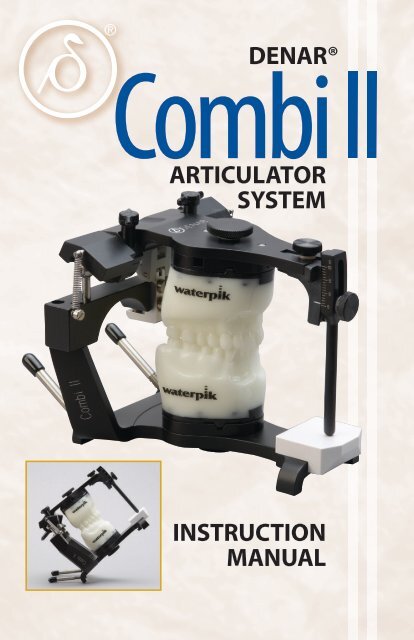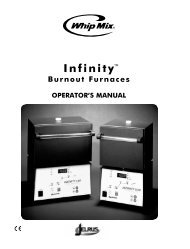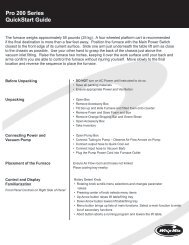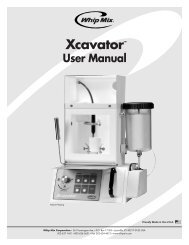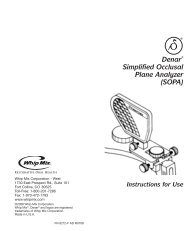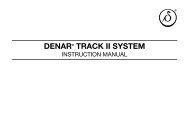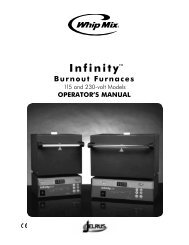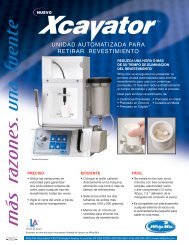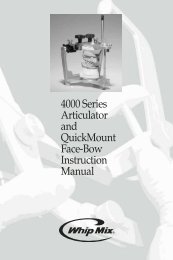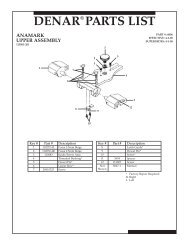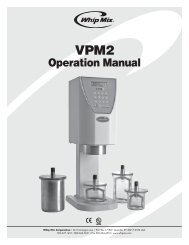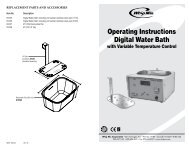denar® articulator system instruction manual - Whip Mix
denar® articulator system instruction manual - Whip Mix
denar® articulator system instruction manual - Whip Mix
You also want an ePaper? Increase the reach of your titles
YUMPU automatically turns print PDFs into web optimized ePapers that Google loves.
DENAR®CombiARTICULATORSYSTEMINSTRUCTIONMANUAL
Instruction ManualAcknowledgementsIt is now easier than ever before to duplicate clinically significantmovements of the patient with the Denar® Combi II <strong>articulator</strong> <strong>system</strong>.New features include adjustable condyles, retaining springs,and recline devices.Special acknowledgment goes to Peter E. Dawson, DDS for writingthe clinical application for the <strong>instruction</strong> <strong>manual</strong>, and for assistingin the development of the design criteria for the Combi II <strong>articulator</strong>.We also thank Dr. John Cranham for his technical insight andsupport during the design phase. Additionally, we received adviceand support from many current users of Denar instrumentationenabling us to develop an articulation <strong>system</strong> based on simplicity,versatility, and cost effectiveness.1
Denar Combi II Articulator SystemTable of contentsAcknowledgement ...................................... 1Introduction ............................................ 3Features ................................................ 3Rationale for Simplicity ..................................4Programming the Combi II. .............................. 7Accessories ............................................ 10Care and Maintenance. ................................. 12References ............................................. 12Warranty. .............................................. 122
Instruction ManualThe New Denar® Combi II Articulator:This instrument has been designed for simplicity and efficiency.The lateral pathway or progressive side shift is fixed at 15 degreesthus eliminating any chance of balancing side occlusal contact. Itis contoured to produce slightly more side shift than can occur in apatient. Thus following this path in lateral excursions guaranteesposterior disclusion of all balancing side inclines. The only adjustmentrequired for condylar path on the Combi II is the protrusivepath or condylar inclination. This can easily be achieved with asimple straight protrusive bite records.The New Combi II Features:• Progressive side shift fixed at 15 degrees• Condylar inclination adjustable 0–60 degrees• Retaining springs hold upper and lower memberstogether and assist in smooth operationof lateral excursions• Ability to tilt the instrument back at a 45 degreeangle• Durable black anodized finish• Field inspection Gage permits transferabilityof casts due to three dimensional calibration• Positive centric latch allows the upper and lowerbows to be separated or positively lockedtogether in centric relation in both open andclosed positions• Rigid, sturdy, and lightweight design• Stable and level in the inverted position• Simple to use• Economical• Arcon construction3
Denar Combi II Articulator SystemThe Rationale For SimplicityThe Denar Combi II ArticulatorFinally, a cost effective, top quality <strong>articulator</strong> that satisfies everyrequirement for accuracy while eliminating unnecessary complexity.The Denar Combi II <strong>articulator</strong> is the perfect choice for analysis,treatment planning, and completion of even the most complex occlusaltreatment. And it does all this with a time-saving simplicitythat is unmatched in <strong>articulator</strong>s costing much more.The Basis for Combi II SimplicityThe reason for complexity in high-end <strong>articulator</strong>s is based on earlygnathological premises that have since been invalidated. The threepremises that complicated <strong>articulator</strong> design are:1. Immediate side shift of the condyles required a complex mechanicaladjustment to record a lateral, horizontal shift of the mandible.This requirement became obsolete when it was determinedthat an immediate side shift cannot happen from properly seatedcondyles in centric relation. (Figure 1)Figure 1: The condyles are braced medially in centricrelation. The orbiting condyle must move down topermit any lateral movement of either condyle. Apurely horizontal side shift before any condylar rotationtakes place is not possible. Thus a horizontalside shift adjustment on an <strong>articulator</strong> has no logicalpurpose. Note how the balancing side condylemust move down before any horizontal shift of eithercondyle can occur.2. The need for precise recording ofprogressive side shift. Precise recordingof the progressive side shift requiresa complex mechanical configurationbuilt into the <strong>articulator</strong>’s condylar paths.This has traditionally been accomplishedthrough use of pantographic tracings orbite records taken in lateral excursions.The practice resulted from an early gnathologicgoal of bilateral balance of posterior teeth in lateral excursions,an acceptable goal for complete dentures, but contra indicatedfor natural dentitions. Since research has shown that posteriorcontact in lateral excursions is a frequent cause of muscle hyperac-4
Instruction Manualtivity, posterior disclusion of all balancing side contact has becomethe desired goal. Posterior disclusion can be routinely achieved bya simple process that eliminates the need for complex recordingsand costly mechanical paths on the <strong>articulator</strong>.The Simplified Combi II Solution. Two studies involving morethan 1000 patients showed the maximum horizontal path inclineto be 10˚. By setting the lateral pathway at 15˚ any chance of balancingside occlusal contact can be eliminated. Since there is nevera time when balancing side contact is desired on dentulous patients,separation of all balancing side contact in lateral excursionsis always the goal. There is never a need to change the progressiveside shift on the Combi II <strong>articulator</strong>.Figure 2. The progressive side shift path is built intothe condylar path on the Combi II. It is contouredto produce slightly more side shift than can occurin a patient. Thus following this path in lateral excursionsguarantees posterior disclusion of all balancingside inclines. It has no negative effect onany other aspect of occlusal harmony.Figure 3. The arrow shows the maximum medialmovement possible by the balancing side condylein the patient. The path shown on the condylarpath of the <strong>articulator</strong> shows the medial movementthat occurs during the restorative process.This insures posterior disclusion.3. The need for a precise protrusivepath. The requirements for <strong>articulator</strong> design changed dramaticallywhen research studies and clinical experience determined thatposterior teeth should ideally be discluded the moment the mandiblemoves forward of centric relation (Figure 4). This informationcombined with studies showing the flattest protrusive condylarpath is 25˚ resulted in a major simplification in the restorative process.Since protrusive contact on posterior teeth is never a desiredresult, disclusion can be achieved by setting the condylar path on aflatter angle than the patient’s forward path. There are no negativerepercussions from an arbitrarily flattened condylar path on the<strong>articulator</strong> as long as posterior disclusion can be achieved by theanterior guidance in the patient.5
Denar Combi II Articulator SystemFigure 4. The ideal functional relationship isimmediate separation of all posterior teeththe moment the mandible moves forwardfrom centric relation. Extensive studies haveshown that this results in shutting off mostof the elevator muscle contraction to reduceloading forces on the TMJs and the anteriorteeth. Setting the condylar path flatter on the<strong>articulator</strong> will result in faster separation of theposterior teeth if the condyles travel a steeperpath forward in the patient. This has no adverseeffect on function, comfort, esthetics, orstability.When recording, the protrusive condylar path is important.There is never a problem with condylar guidance if the anteriorguidance can disclude the posterior teeth in all excursions. But ifposterior disclusion cannot be achieved, it may be necessary to relymore on the condylar path to help separate the posterior teeth. Insuch cases it is important to determine the protrusive path. This isthe only adjustment required for condylar path on the Combi II. Itcan be easily achieved with a simple straight protrusive bit recordto set the protrusive angle.6
Instruction ManualProgramming the combi iiIn addition to a facebow recording (Figure 5) the only recordsneeded for complete programming of the Combi II are:1. a centric relation bite record2. a protrusive bite record.If anterior teeth are to be restored a customized anterior guidanceis fabricated to precisely copy the desired guidance.Figure 5. Slidematic earbow torecord condylar axis.Figure 6. The upper cast is relatedto the condylar axis. The index forthe earbow fork corrects the positionof the cast to relate it to thecondylar axis instead of the earholes. This is an automatic correction.Figure 7. A centric relation biterecord is made.Figure 8. The lower cast is relatedto the upper cast by alignmentinto the centric relation record.7
Denar Combi II Articulator SystemFigure 9. The completed mountingpermits closure of the casts to contactin centric relation.Figure 10. A protrusive bite recordis made with the mandible advanced5-10 mm. Indentations ofall upper and lower teeth shouldbe definite.Figure 11. Release the retainingsprings and centric latch. Positionthe upper cast firmly into positionin the protrusive bite record. Setthe condylar path at 0˚.Figure 12. When casts are positionedin the protrusive bite recordthe condyle balls will be down andforward in space.Figure 13. Release the thumb screwand rotate the condylar path downuntil it touches the condyle ball onboth sides.8
Instruction ManualFigure 14. Tighten the thumb screwto lock the condylar path angle inplace. Remove the protrusive biterecord. The condylar path settingis completed.To guarantee complete posterior disclusion in all excursionsrelease the thumbscrew and flatten the protrusive path by5˚. The progressive side shift is automatically set to discludethe balancing side occlusion. Restorations that are made todisclude on this <strong>articulator</strong> will not interfere in any excursion.That is the goal of every finished occlusion.9
Denar Combi II Articulator SystemThe Perfect SystemThe Denar Combi II is compatible and interchangeable with accessoriesthat fulfill every requirement for occlusal perfection. No other<strong>system</strong> can match its simplicity, versatility, or cost effectiveness.AccessoriesDenar® Centri-Check SystemThe simplest of all <strong>system</strong>s for verifyingcentric relation or documenting comparativecondylar positions on reusablepatient inserts. The condyle balls onthe Combi II are pre-drilled to guide aneedle point recorder.By simply squeezing the casts together,the amount of horizontal and verticaldisplacement of the condyle can be accuratelymeasured for use in monitoring splinttherapy and analyzing cephalometric recordings.Denar® Slidematic FacebowThe time-saving design of this deviceeliminates the need for transferringthe entire facebow to the <strong>articulator</strong>.It is a fast, easy and accurate means oftransferring the proper maxillary relationships.Transfer only the transfer jigassembly to the <strong>articulator</strong> thus freeingthe measuring bow to be used for thenext patient.10
Instruction ManualAccessoriesSimplified Occlusal Plane AnalyzerDesigned for analyzing the Curve of Speeand the Curve of Wilson.Dawson Fossae-Guide PinUsed to simplify carving of occlusal fossaeof lower posterior teeth. Provides for fossaewall angles shallower than the incisal guidance.Used with a custom (flat) incisal table.Occlusa-Check®Used for the detection of occlusal interferencesof restorations while they are still onthe <strong>articulator</strong>. When the pin locks into theslot, the restoration is the correct height. Ifthe restoration is built too high, the pin willnot go into the slot.Magnetic Mounting SystemProvides magnetic retention without addingsteps to the process, casts are mountedin one quick step. Compatible with all Denar®and Hanau <strong>articulator</strong>s.11
Denar Combi II Articulator SystemCare and MaintenanceYour <strong>Whip</strong> <strong>Mix</strong> <strong>articulator</strong> is a precision instrument and requires care and maintenance.Periodic cleaning and lubricating as described below will assure prolongedlife and dependable service from the instrument. Failure to follow these<strong>instruction</strong>s will void your warranty.CleaningUse a mild soap and water solution with a very soft brush to dissolve accumulationsof wax and to wash away carborundum grit. Then air dry and lubricate. DONOT use strong detergents, alkalies, gasoline or naphtha as cleaning agents!LubricationLubricate the working and bearing components with a thin film of sewing machineor high speed handpiece type oil. Wipe off excess oil to prevent accumulationsof dust or grit. A thin coating of petroleum jelly must be applied to all<strong>articulator</strong> surfaces that will be contacted by the gypsum mounting material.StorageStore the <strong>articulator</strong> in a clean, dry atmosphere free of plaster and carborundumdust, away from acids, alkalies or corrosive medicaments. Wait a full dayafter mounting casts before storing the <strong>articulator</strong> in a carrying case orcorrugated carton. Moisture dissipation from the stone in an enclosed areacauses alkalinity of the stone mixture which can damage the <strong>articulator</strong> surface.ReferencesDawson, Peter E.: Evaluation and Treatmet of Occlusal Problems, Second Edition;1989Dawson, Peter E.: Functional Occlusion: From TMJ to Smile Design; August2006Lundeen H: Condylar Movement Patterns Engraved in Plastic Blocks, Journal ofProsthetic Dentistry 30 (6): 866-875; 1973Ricketts RM: Orthodontic Diagnosis and Planning: Their Roles in Preventativeand Rehabilitative Dentistry. Denver, 1982, Rocky Mountain Orthodontic.Warranty<strong>Whip</strong> <strong>Mix</strong> Corporation warrants the <strong>articulator</strong> <strong>system</strong> to be free from defectsin material and/or workmanship for a period of one year. In the event of a defect,please notify the factory in writing of the defect prior to returning theinstrument. <strong>Whip</strong> <strong>Mix</strong> Corporation will, at its option, either repair, replace orissue credit for such defects.Because <strong>Whip</strong> <strong>Mix</strong> Corporation is continually advancing the design of its productsand manufacturing method, it reserves the right to improve, modify ordiscontinue products at any time, or to change specifications or prices withoutnotice and without incurring obligations.12
<strong>Whip</strong> <strong>Mix</strong> Corporation - West1730 East Prospect Rd., Suite 101Fort Collins, CO 80525Toll-Free: 1-800-201-7286Fax: 1-970-472-1793www.whipmix.com<strong>Whip</strong> <strong>Mix</strong>®, Denar® and logos are registered trademarks andHanau is a trademark of <strong>Whip</strong> <strong>Mix</strong> Corporation.©2008 <strong>Whip</strong> <strong>Mix</strong> Corporation.FN 20010150-F AB R0408


